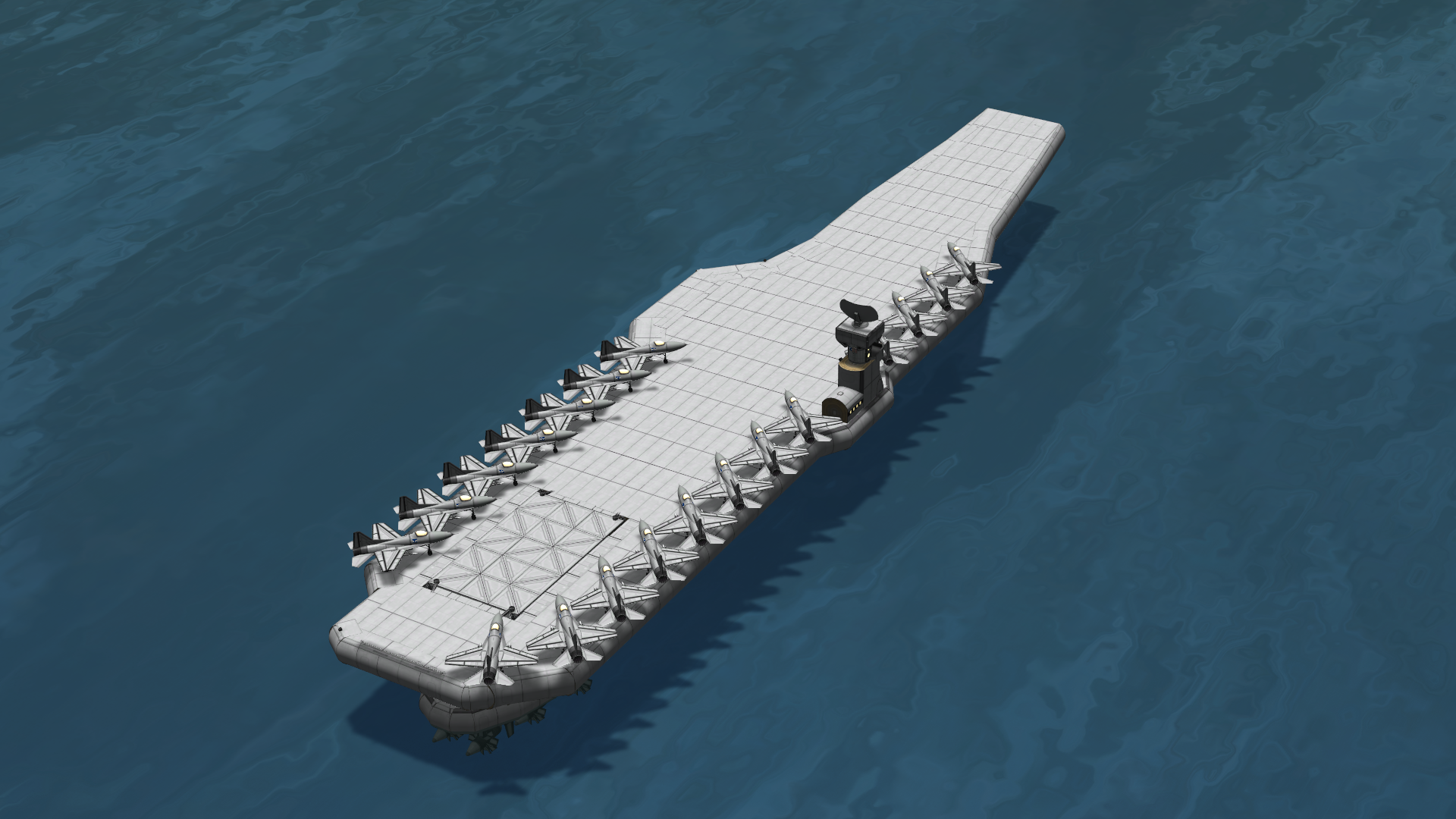Thunderbird-Class Aircraft Carrier
|
Thunderbird Class
Thunderbird Class aircraft carrier
|
|||||
|---|---|---|---|---|---|
| Ship | |||||
 |
|||||
| The VN 'Errant Herald' sets sail with a full complement of 26 VAA Taiowa light fighters | |||||
| Role | Aircraft carrier | ||||
| National Origin | Vocavium | ||||
| Production History | |||||
| Produced | |||||
| 2081 - 2083 | |||||
| Designer | Vocavian Shipbuilding Department | ||||
| Unit Cost | about 4 quarters(√) | ||||
| Number Built | 2 | ||||
| Service History | |||||
| In Service | |||||
| who knows - ongoing | |||||
| Used By | Vocavium | ||||
| Vessel Characteristics | |||||
| Displacement | 2,850 tonnes | ||||
| Length | 143 m | ||||
| Beam | 35 m | ||||
| Height | 30 m | ||||
| Propulsion | 6 electric engine pods, each housing a pair of 8-bladed contra-rotating propellers, powered by 2 fuel cells | ||||
| Max Speed | 60 kn (30 m/s) | ||||
| Operational Range | idk km | ||||
| Complement | idk | ||||
| Sensors and Processing Systems | |||||
| Armament | idk | ||||
The Thunderbird Class was a class of 2 supercarriers in service with the Vocavian Navy. The class derives its name from the primary god of the sky and cosmos in Vocavian mythology. When first introduced, they were the largest warships to serve in the Vocavian Navy, and among the largest surface vessels ever put to sea. The first of the class, the VN 'Errant Herald' was laid down in 2080 and entered service in 2081. Her sister ship the VN 'Mountain Forge' was set to enter service in early 2082, however in 2083 the Thunderbird Class was cancelled due to spiralling costs and budget overruns. The experimental construction methods utilised to give the hull greater rigidity proved too expensive on such a large scale, and subsequently development of the class was postponed indefinitely.
Instead, development began on a new class designed to incorporate many of the Thunderbird Class's features, such as fuel cell propulsion, an internal hangar and elevators.
The Thunderbird Class represented a quantum leap in ship building design, and was pivotal in paving the way to a new era of large vessels incorporating the latest techniques in ship manufacturing and technology. As such, many experts in the field have begun referring to large ships with similar characteristics since the commissioning of the class as 'Thunderbirds'; "Boy, look at the size of her! She's a real Thunderbird!".
Design
Design work for the Thunderbird Class began shortly after the Vocavian Federation was founded in order to quickly establish Vocavium as a military power. Chieftain Shatter-Horn ordained the construction of a large carrier capable of supporting a complement of 20 aircraft in order to project Vocavian naval power to greater ranges. The ships were designed to build open the construction techniques those used by merchants who built particularly large cargo ships that traversed the K'yangtze river, built with remarkable rigidity and strength in order to withstand the rough water conditions common in the bay, due to the Avem mountain's micro-climate. The Vocavian Shipbuilding Department (VSD) submitted a proposal for a 143m vessel fitted with an internal hangar and elevator for access, boosting the carrier's storage capacity. The proposal was approved and in 2080 the Vocavian Navy placed an order for 2 ships. Using the knowledge accrued from years of robust shipbuilding, the type was able to be large enough to accommodate 26 fighter aircraft, exceeding the original design specifications. It has a total length of 143m, a beam of 35m and a total height of 30m.
The Thunderbird Class utilises a ski style ramp to launch aircraft, making it suitable for even large AEW and tanker aircraft to use the flight deck. The deck is shaped to allow carrier operations to efficiently take place. The protrusion on the port side of the deck, referred to as 'the bulge' by carrier personnel, enables aircraft to manoeuvre after landing towards the elevator. Therefore it is kept clear at all times and is not suitable for aircraft storage.
One of the most prominent and integral features of the ship's design is the aircraft elevator located towards the stern of the ship, used for traversal between the flight deck and the hangar. The system utilises four hydraulic pistons to raise a platform to become part of the flight deck. The system is rated for loads of up to 40 tons.
The bridge of the Thunderbird Class is located on the starboard side, resting on a protrusion from the flight deck which also serves the function of carrying fuel. From the bridge, all flight deck operations are controlled and managed, mean a high vantage point is required. This resulted in the large platform intended for excellent viewing of the deck. The Bridge also houses the ship's 34 crew members. Another area mess area is located in the bow of the ship and is accessible from the hangar, with room for 16 pilots.
Propulsion
The Thunderbird Class utilises a unique method of electric propulsion. All ships of the class are outfitted with 6 engine pods, each housing a pair of 8 bladed contra-rotating propellers. The engines are driven by electric motors, which are in turn powered by a pair of fuel cells within the heart of the ship. This system gives the class a top speed of up to 60 knots whilst at the same time offering unparalleled efficiency. When fuelled to her operating capacity, the class has a range of over 50,000km, sufficient to circumnavigate the planet 13 times before refuelling. However, the operating capacity of the class is purposefully limited to control the balance of the ship. If it were filled to its true maximum capacity, it would have a range of more than 2,300,000km, enough for over 620 circumnavigations.
The system was originally conceived in a diesng submission by Teuthida Dynamics, a shipbuilding company of great renown throughout Vocavium that specialise in nuclear propulsion, largely for submarines. The design was rejected, though the Vocavian Navy took interest in the proposed propulsion system which suggested two large nuclear powered turbines. It was agreed that VSD would manufacture the hull whilst Teuthida Dynamics would provide the propulsion system. Early on in the design process, the nuclear reactors intended to power the ship were scrapped in favour of a fuel cell system. Reasons for this decision included the comparatively low power output which would be insufficient to for all the systems on such a large vessel, as well as the monumental cost of constructing and decommissioning the nuclear elements.
Aircraft Complement
The Thunderbird Class can accommodate 26 aircraft at full capacity, with space and fuel for each. Typically, however, a variety of aircraft would be deployed for different roles, resulting in a more disparate use of the flight deck and a reduction in the number of aircraft. A wing of 18 dedicated fighter aircraft may be expected in a combat deployment, with a further 6 aircraft that may be dedicated attackers or support planes, such as AEW aircraft and tankers.
Service History
2080-2083
The first ship of the Class to be commissioned was the VN 'Errant Herald', laid down in 2080 entering service in 2081. In early 2081, the 'Errant Herald' completed a shakedown cruise around the Westray Peninsula, used to ascertain her performance. In a speed trial, she briefly reached 31.2m/s in calm water much to the crews delight, though the chief engineer took a rather more dim view after it was revealed that the high speed had misaligned a propeller blade on the starboard engine pod. Returning to port, repairs were made and the ship was for the first time fitted with a full complement of fighters. 26 VAF Taiowa light fighters were dispatched and assigned to the carrier for a full patrol. After 75 days the 'Errant Herald' completed her first, and last patrol, returning to port on the same day as the programme's cancellation. Whilst her semi-completed sister ship was deconstructed for materials, the 'Errant Herald' remains a commissioned warship, though it is doubtful she will return to active duty.

